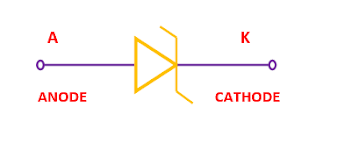What is an Avalanche Diode?
An Avalanche Diode is one of the varieties of the semiconductor
diode which is specially designed to work in the reverse breakdown region. In
other words, the diode breakdown occurs due to the avalanche effect is known as
the avalanche diode.
The construction of an avalanche diode is equivalent to or similar
to the Zener diode but the doping level is differing from the Zener Diode. The
avalanche diode is lightly doped thus, the width of the depletion region is
thick and the Zener diode is heavily doped thus, the width of the depletion
region is very thin.
The normal diode allows passing the current in one direction i.e. forward direction. Whereas, avalanche diode allows to pass the current in both the directions i.e. forward and reverse direction but the avalanche diode is specially designed to work only in reverse bias condition.
 |
| Avalanche Diode Symbol |
V-I Characteristic of the Avalanche Diode
The V-I characteristics of the
Avalanche Diode are shown in the figure below. It shows that the Zener
breakdown occurs at a breakdown voltage of nearly 4 V under reverse bias
condition whereas, the avalanche breakdown occurs at a breakdown voltage of more
than 6 V under reverse bias condition.
 |
| V-I Characteristics of an Avalanche Diode |
What is an Avalanche Breakdown Voltage?
In a diode, when we increase the reverse bias voltage across a P-N
junction then the reverse saturation current remains constant up to a certain limit
but If further increase reverse bias voltage then it will breakdown the P-N junction,
and hence, the reverse current increases sharply to a high value. This critical
value of reverse bias voltage at which the reverse current increases sharply is
known as the avalanche breakdown voltage.
Usually, the avalanche breakdown occurs at a breakdown voltage of more than 6 V.
When an Avalanche Effect or Avalanche Breakdown Occurs?
The avalanche effect or the avalanche breakdown occurs in lightly doped p-n junction diode under the reverse bias condition.
Comparison Between Zener Breakdown and Avalanche Breakdown
The difference between the Zener
breakdown and the avalanche breakdown is given in the table below.
|
Avalanche Breakdown |
Zener Breakdown |
|
Avalanche
Breakdown occurs in a lightly doped P-N junction diode under the reverse bias
condition. |
Zener
Breakdown occurs in a heavily doped P-N junction diode under the reverse bias
condition. |
|
Avalanche
Diode has a wider (thick) depletion region. |
Zener diode
has a narrower (thin) depletion region. |
|
The Electric
field set up across the depletion region is weak due to a wide depletion
region. |
The Electric
field set up across the depletion region is strong due to a narrow depletion
region. |
|
The Avalanche
Breakdown occurs due to the collision of accelerated charge carriers with the
adjacent atoms and due to carrier multiplication. |
The Zener Breakdown
occurs due to the breaking of covalent bonds by the strong electric field across
the junction. |
|
The Avalanche Breakdown
occurs at a breakdown voltage of more than 6 V. |
The Zener breakdown
occurs at a breakdown voltage of less than 4 V. |
|
The breakdown
voltage increases as junction temperature increases. |
The breakdown
voltage decreases as junction temperature increases. |
|
The
temperature coefficient is positive. |
The
temperature coefficient is negative. |
|
The avalanche
breakdown is not reversible. |
The Zener
Breakdown is reversible. |
Is Avalanche Breakdown Reversible or Not?
The Avalanche breakdown is not reversible. As the Avalanche
Breakdown occurs due to the collision of accelerated charge carriers with the
adjacent atoms and due to carrier multiplication. Whereas, Zener Breakdown occurs due to the breaking of covalent
bonds by the strong electric field across the junction. Hence, the Zener
breakdown is reversible.
Avalanche breakdown can be reversible if we connect the resistor in series
with the diode.
How the Avalanche Breakdown Is Not Reversible and the Zener Breakdown Is Reversible?
When a P-N junction of the diode is in Zener breakdown condition and
if we decrease the external reverse bias voltage, then the P-N junction is not
damaged and returns to its initial state. Hence, the Zener breakdown is
reversible.
whereas, if a PN junction of the diode is in avalanche breakdown
condition and if we decrease the reverse bias voltage, then the P-N junction
can’t return to its initial state. Hence, in the avalanche breakdown condition,
the P-N junction is permanently damaged. Hence, the Avalanche Breakdown is not
reversible.
Applications of an Avalanche Diode
Some applications of the avalanche diode have been discussed below.
- The Avalanche diode can be used to protect the circuit. In a diode, when reverse bias voltage rises up to a certain limit then an avalanche effect starts in the diode at a particular reverse bias voltage and the breakdown of the diode occurs due to the avalanche effect.
- The Avalanche diode is used to protect the circuit against unwanted voltages.
- The Avalanche diode is used as surge protectors to protect the circuit from surge voltage.



Nice article
ReplyDeleteWonderful article
Delete